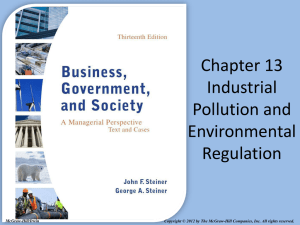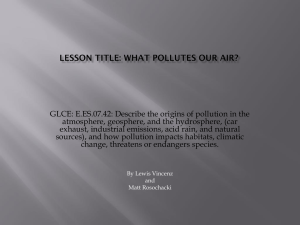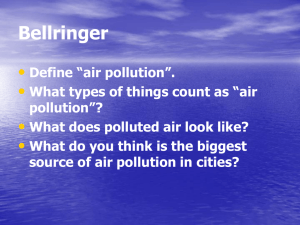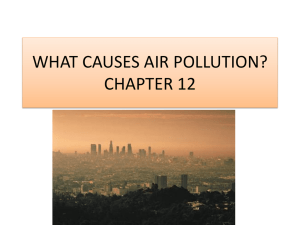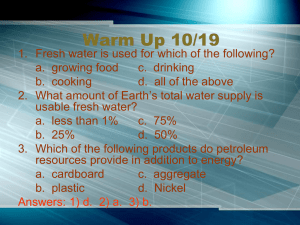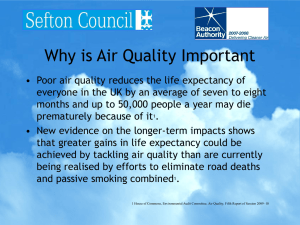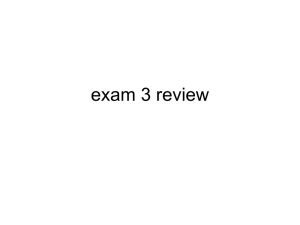Air Pollution
advertisement
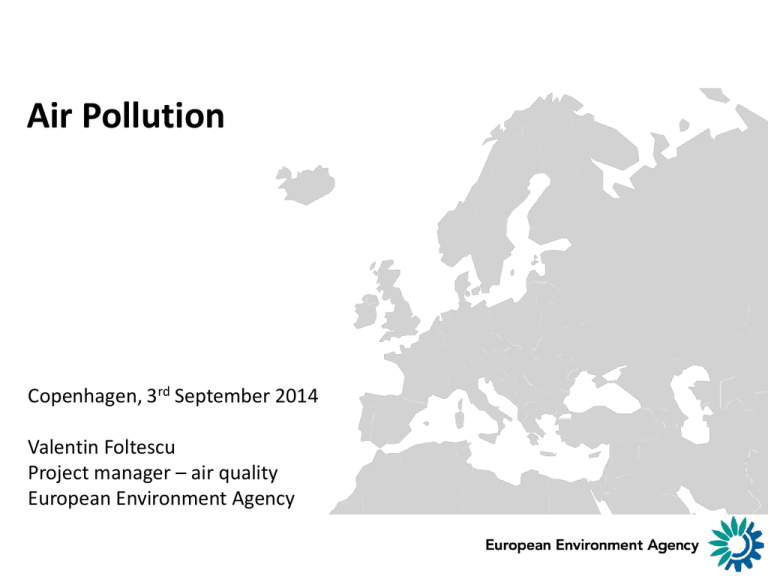
Air Pollution Copenhagen, 3rd September 2014 Valentin Foltescu Project manager – air quality European Environment Agency Air pollution, transport and noise MAWP Strategic Area 1.1 Objective To support and inform policy development and implementation in the areas of air pollution, transport and environment and noise by means of data, information/indicators and assessments. Specifically • to collect, process, quality-assure, store, and disseminate historical — and where possible up-to-date (i.e. near-real-time) — data underpinning these policies; • to track progress towards, and provide outlooks for, the achievement of targets as defined in relevant EU and international legislation, including the long-term objectives of minimising impacts from air pollution and the decarbonisation of the transport sector. What are the main concerns for Europe’s air? Particulate matter (PM) and its threat to human health. Ozone (O3) due to its health impacts and harm to vegetation. Eutrophication from high emissions of nitrogen oxides (NOx) and ammonia (NH3). These pollutants can cause harmful atmospheric deposition of nutrient nitrogen to sensitive ecosystems, such as grasslands and nutrientpoor lakes. Exposure to harmful levels of air pollution EU urban population exposed to harmful levels of air pollution, according to: EU limit values WHO guidelines Up to a third of Europeans living in cities are exposed to air pollutant levels exceeding EU air quality standards. And around 90 % of Europeans living in cities are exposed to levels of air pollutants deemed damaging to health by the World Health Organization’s more stringent guidelines. (based on 2011 data in AirBase). Countries are exceeding EU air quality standards In 2011, 18 EU Member States exceeded the target value threshold for ozone (O3) concentrations on more than 25 days. During the same year, 22 EU Member States exceeded the EU daily limit value for particulate matter (PM10) concentrations. The European policy response EU legislation limits the emissions of pollutants and sets maximum levels for concentrations of these pollutants in the air. For pollutant emissions, the 2001 National Emissions Ceiling (NEC) Directive sets ceiling limits for emissions of SO2, NOX, NMVOC and NH3. These ceilings should have been met by all EU Member States by 2010. These ceilings are supported by a range of sectoral measures controlling emissions from road transport, industry, etc. For pollutant concentrations, two Air Quality Directives (2008/50/EC and 2004/107/EC) set legally binding limits and target values for ground-level concentrations of outdoor air pollutants. Data, analyses and assessments at subnational level Emissions data – E-PRTR Pollutant release data from facility-level reporting to European Pollutant Release and Transfer Register (E-PRTR) • • • • • http://prtr.ec.europa.eu/ Releases to air, water, land and off-site waste transfers from 30 000 industrial facilities. Updated annually Included facilities are defined in E-PRTR Regulation Annex I EC 166/2006 Coverage: EU28 + NO, IS, LI, CH, RS A cooperation between DG ENV and EEA Air quality management zones and attainment status • Metadata for monitoring in zones • Exceedance and/or concentration data for all regulated pollutants: PM10, PM2.5, O3, SO2, NO2, CO, VOC, PAH, benzene, toxic metals • Supplementary assessment by modelling • Population exposed • Info on natural contributions • Info on winter sanding/salting • Info on transboundary pollution • http://www.eea.europa.eu/dat a-and-maps/data/zones-inrelation-to-eu-air-qualitythresholds-5#tab-gis-data AirBase - The European air quality database 2012 data (v. 8) Total reporting countries Total number of stations SO2 NO2 NOx PM10 PM2.5 Pb CO C6H6 O3 As Cd Ni Hg TSP (aero.) BS Bap (PM10) 36 37 37 38 33 24 36 34 37 22 24 23 6 17 15 21 4552 5335 4302 4492 1448 824 2522 1538 3508 447 530 484 69 1365 618 770 http://www.eea.europa.eu/data-and-maps/figures/airbase-exchange-of-information-5 Interactive AirBase Search for a location and/or click on a station to learn more about its air quality http://www.eea.europa.eu/themes/air/air-quality/map/airbase/air-quality-statistics-at-reporting-stations Interactive real-time air quality data http://www.eea.europa.eu/themes/air/air-quality/map/real-time-map Spatial data: Pollutant concentrations http://www.eea.europa.eu/themes/air/air-quality/map/airbase/air-quality-interpolated-maps Spatial data: Ozone concentrations threat to crops Exposure levels of European agricultural areas to ozone (O3): High levels of O3 concentrations harm human health and agricultural output. Losses of crop yields also have consequences for the European economy. Source: EEA CSI005 indicator Spatial data: eutrophication and acidification Source: EEA CSI005 indicator Trends in pollutant concentrations Air quality in (urban audit) cities Pollution status for PM, O3, NO2 and BaP by: • concentrations • exceedances of air quality standards • affected population AirBase stations are mapped with a total of 761 cities available from the eurostat “urban audit2012” data set, for a total population of 173 875 740. Air Implementation Pilot: Implementation • Communication on implementing issues • Air Policy Review • 7 Environmental Action Plan Focus on Implementation Implementation: not only compliance but collaborative work to build capacity and knowledge to get a more effective policy PILOT: 1. To identify implementation challenge 2. To identify how to address it 18 Air Implementation Pilot: description A joint project: DG ENV + EEA + cities experts Objectives: • Better understand challenges faced when implementing AQ legislation. • Exchange of experiences (good practices) also with other cities • Develop general proposal to improve implementation. • Not intended to solve AQ problems, but improve information base for future action Workstreams: • Emission inventories • Modelling • Monitoring networks • Management • Information to the public 19 Air Implementation Pilot: conclusions • Some conclusions from the working streams: – Need of training and guidance, improved input data – Lack of competences – Need of further support from European legislation/regulations • Feedback from cities for further steps – Potential to strengthen local assessment and management capacities – Follow up communication momentum (using existing networks?) – Keep on supporting exchange of experiences (for instance, using new cost-effective technologies) 20 Air pollution publications 2014 EEA publications ● Air quality in Europe – 2014 report ● Towards integrated assessment of air quality and climate policies ● Updated costs of air pollution from industrial facilities in Europe ● Annual Transport and Environment Reporting Mechanism report (TERM) ● CO2 emissions performance of car manufacturers in 2013 ● Air pollution by ozone across Europe during summer 2013 ● Annual NEC Directive status report 2013 ● European Union emission inventory report under the UNECE LRTAP Convention ● Impacts of air pollution on Europe’s ecosystems - acidification and eutrophication Thank you Valentin.Foltescu@eea.europa.eu How can Europe respond to the air quality challenges? Continued investment in the knowledge base Together with other techniques, air monitoring stations across Europe feed the knowledge base on air. While some of the monitoring stations may have been substituted by other techniques, it is important to maintain, and in certain cases improve the monitoring infrastructure. Further emission reductions Emissions of some pollutants from certain sectors have increased over the last decade. For example, emissions of PM have increased from homes and commercial facilities. Air pollutant emissions from farming have also changed little in the same period. Capacity building for implementation The gap between EU air quality targets and the reality of European air quality points to the need for better implementation of air quality legislation. Implementation can be improved by building capacity over time and by better understanding the specific problems when implementing environmental legislation. Countries to meet existing emission and AQ targets Too many countries are still not in compliance with EU emissions ceilings. These countries must make a renewed effort to reduce their emissions.
